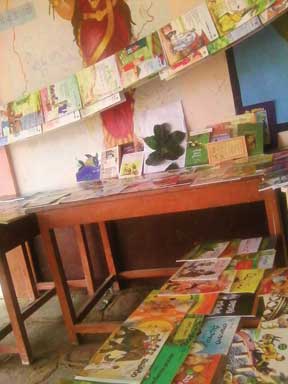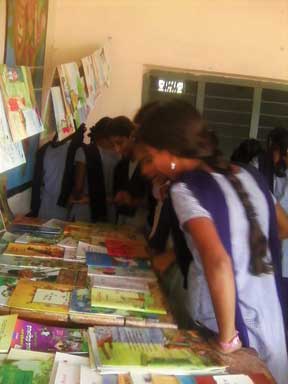Anuradha Pachanooru
I got a call from a student of a school I worked in two years ago. She called to talk to me about the school library and my role in helping change the way the school was functioning. She shared how the library continued to be active. Children were learning paper craft and participating in other activities that the school library was now conducting. Her phone call made me immensely happy. The changes I managed to effect in the school library were all part of a project I had undertaken to transform a government school in Hyderabad as part of a CSR initiative.

Over the last two decades, I have worked on different projects in different government schools. But this particular project was special. My role was to develop logical and critical thinking skills in children, and for this reading and writing skills were the major focus. Based on my experience, I felt that for the children’s overall development and to enhance their reading and writing skills, the library was the best place, and books, the best tools. My experience of working in a non-formal school for over 20 years, where books were the core focus and source for my teaching convinced me that I was on the right path with this project. I thus began my work in the school library. The school had a typical library room with three locked cupboards. There was no librarian; one of the teachers was in charge of maintaining the registers. There were all kinds of books in the library: folk-stories, animal stories, subject related books, dictionaries, maps, newspaper cuttings, old magazines, information books, history and agriculture themed books and general knowledge and technology books. Most of the collection, however, was useful to high school students only, there were not too many books for younger readers. Both the children and teachers were using the books in the library only as reference materials for their projects or classes.
The library was also being used like a storeroom for the school’s broken furniture. This meant that there was little space for the children to sit and read, and it certainly wasn’t a conducive environment for children to browse through the books. The teacher in charge had given the responsibility of the library to some of the older children. These children maintained registers for issue and return of books and also one to enter any new books. Teachers who wanted reference books from the library asked these children, who would take out the books for their teachers and also put them back after use. Although the school timetable displayed two library periods a week, most of the time the children just played or chatted outside the room.
When I undertook this project, I first looked at what kind of books the library had and what condition they were in. Then I asked the children how they were using the library and what problems they were facing if any. After my small survey, I held a meeting with all the teachers and explained to them the importance of the library and the need to support a reading habit in children. I shared how reading can help increase literacy and children’s understanding. Then I discussed my recommendations with the funders and received the necessary budget to buy new books and storage cupboards for the library. I worked with the teacher in charge and together with the help of the children we listed all the books in the library in a register. Then I organized a book festival. I displayed all the books I had bought together with the books already available in the school library and invited all the children and teachers to come take a look at the books and spend some time with them.
If you think that this little exercise brought about a change in attitude and helped breathe life into the school library, then you are wrong. Why? Because all the books went back into locked cupboards as the teacher in charge felt that it was her most important responsibility to safeguard the books.
With the school library clearly out of bounds for everyday use, I started carrying storybooks from my personal collection to school to read aloud in the classroom. I tried, everyday, to have the library opened for the children’s use. But many thoughts and unanswered questions were beginning to bother me. It was at this time that I heard about the “Library Educator’s Certificate (LEC) Course by Bookworm Trust”. I joined the course along with a friend. This course changed my understanding of the library, the role of the librarian and the place of a library in society. It changed my views on library space and strengthened my beliefs in the role of the library.
I have to mention some of the readings and quotes that I came across during this course. In one reading Sujata Noronha, Founder Bookworm Trust said, “When a student/child walks into a library space, there is a need to create a welcoming atmosphere. This can be imagined in multiple ways and should be created based on the culture of the community/school. Looking at the library as a space and not just a collection of books managed by a human allows one to imagine a more composite image. Thus, walls, shelves, floor, desks/counter space, display areas, notices are all part of the imagination of the physical features of a library.”(Noronha, Sujata 2014, Why a Library Program in Schools and the Community)

I also read about the importance of school libraries. “The school library supports the student’s studies. Every library collection will have information that improves students’ understanding of the subjects they learn at school, and increase their knowledge of the world. As well as providing access to information, a school library allows students to develop the skills of searching for information on their own. This will help to develop a problem-solving and active approach to learning.” (Setting Up and Running a School Library by Nicola Baird) Many such readings and interactions that I had in the LEC course gave me a totally different understanding of my library work, which has strengthened all that I am doing now. With my new knowledge, I started working differently with the school to sort out the issues I was facing and took it up as my Field Project work for the LEC course.
I decided to set up a “classroom library”. Since the teacher in charge would not allow me to take the library books, once again I used books from my own collection. Slowly, the children began sharing with other teachers what they did with the storybooks in the classroom. I too started talking about the classroom library in staff meetings. I would pick up a book from the classroom library and read stories aloud, have storytelling sessions, have children read out from the books, encourage them to take books home and bring them back the next day or next week. Slowly, reading and book borrowing were becoming daily practices. Children took books home to read by themselves as well as to their siblings, parents, friends and neighbours. These books became very important to the students. They created a lot of interest, helped the children build a relationship with the stories they read, developed their thinking skills and assisted the children in making meaning of their own world in conversations that opened up after every reading. Every day, the children would wait for a fresh story, knowing there would also be a discussion about what happened in the story the following day. Questions about a particular character or situation or on different issues arising in the story interested the students greatly. The children had different opinions, thoughts, likes and dislikes. As Descartes, the French mathematician and philosopher said, “The reading of all good books is like conversation with the finest minds of past centuries.” “This is the personal and direct contact we can make through something as simple as reading! Reading raises questions, sparks off ideas and starts a chain of imaginative thought. They are responding to strong themes, to evocative language and are being exposed to issues they cannot afford to ignore. They are able to get in touch with their own emotions, fears and joys.” (The Manual for an Open School Library – Usha Mukunda.)
The children loved to dress up as different characters and tell their stories. Such activities improved their vocabulary, grammar and comprehension. These activities also gave them different perspectives and developed critical thinking and appreciation of content.
Now, the children’s learning was not restricted only to the textbooks, which most of the time are not related to students’ realities. The library helped those children who have fewer opportunities for any kind of literary exposure in their homes or community to feel connected with a larger world.
Later, after many years, when we meet children, these books and this experience will become important topics of discussion and shared collective memories. I have had a reading habit ever since I was young; my profession is such that I continue to read a lot and this has helped me to grow both as a teacher and as an individual. And this particular project and the LEC course helped me grow to become a most wanted storyteller in the schools I work in. Sometimes the books became my guides to understanding the reality of life, sharing the pain, the confusions of others; sometimes I become a role model for many children and teachers.
My learnings
• I am able to see the difference in the children’s attitude in the classroom, where they are not wasting time in making noise and idle chatter but are reading books. Children are capable of full responsibility which they showed me by being in charge of all the books and activities.
• Children shared their experiences with the stories and opened up in the library differently.
• The teacher in charge of the main library was curious to know if the children had stolen any books and was surprised when I told her, “NOT AT ALL”.
• All the teachers in the school began to talk about the library and they also started reading stories in the classroom. When the teacher in charge was retiring from the school, she herself donated storybooks to the library.
Since that project I have been doing a lot of things related to library work. My job/role may be different on each project, but the library is constant and it will continue to be so wherever I may be.
The author is a teacher and library educator based in Telangana. She is the author of many stories including Under the Neem Tree illustrated by A V Illango and published by Tulika. She can be contacted at anuradhap2006@gmail.com
